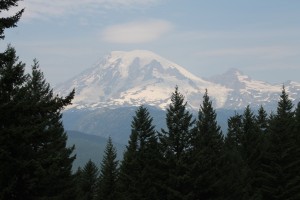We spent two nights on Whidbey Island with an interesting couple who are part of a
Buddhist cmmunity. They have a lovely home with beautiful landscaping, resident deer, and an observatory. We spent a day hiking and seeing the southern part of the island. We took a ferry to the Olympic Peninsula.
We headed to Sequim (pronounced “skwim”) to stay with another interesting couple who live on the edge of Olympic National Park. Our first day we decided to walk out the Dungeness Spit—a 5.5 mile spit of sand with a lighthouse at the end. We started out in absolute fog, not seeing more than 15-20 feet in front of us. We started walking not sure how far we would go. About a mile from the lighthouse, the fog lifted and it looked inviting so we continued. When we returned to the beginning and looked back to the lighthouse, we couldn’t believe we walked that far. If we had seen it at the beginning, we probably would have never gone!
On our way back to where we were staying – along a forested, mountain road—at 4:30 pm a deer jumped out of the forest and landed on our car. He/She rolled off and down the hill and we had a broken windscreen and messed up front end of the car! What a jolt! We were able to drive slowly to the house but the next morning we had it towed to a body shop. The incident changed much of our remaining time in the North West. We rented a van so that we could haul our bikes and continue on to the MCC bike ride in Idaho. But it meant a return trip across the state of Washington from Idaho back to Sequim to pick up the car after it was repaired.
On to seeing the Peninsula – with our rented van. We drove up Hurricane Ridge, visited Port Angeles, stopped along Crescent Lake, and then stopped along the Pacific coast. We enjoyed the rocks, and small pools, and sand—all in the fog.
-

-
bridge from mainland to island
-

-
Mt Baker from bridge
-

-
couple we stayed with
-

-
observatory
-

-
deer on lawn
-

-
Buddhist temple
-

-
Mt Rainier in distance
-

-
hiking on south of island
-

-
hiking along coast
-

-
looking down to trail head
-

-
Mt Baker from trail
-

-
looking toward Pacific
-

-
Mt Baker
-

-
at beach
-

-
Olympic Mts
-

-
Olympic Mts and ferry
-

-
Olympic Peninsula
-

-
low fog
-

-
second home where we stayed
-

-
starting out Spit
-

-
lighthouse in distance
-

-
lighthouse
-

-
Dungeness Spit
-

-
Mt Baker from spit
-

-
towing the car
-

-
our rented van
-

-
Mt Baker
-

-
Olympic Mts
-

-
mountain flowers
-

-
Crescent Lake
-

-
fog at beach
-

-
big cedar tree
-

-
interesting trees
-

-
interesting trees
-

-
stone octopus
-

-
logs at Port Angeles
-

-
coast
-

-
fog at coast
-

-
foggy day
-

-
coast














































































































